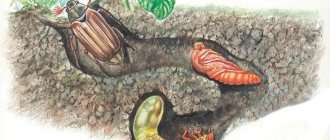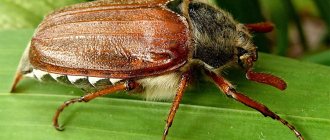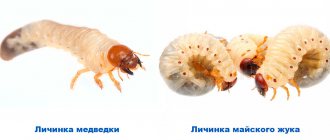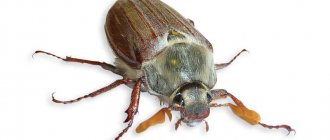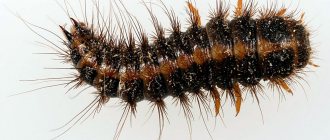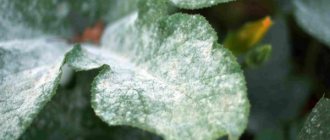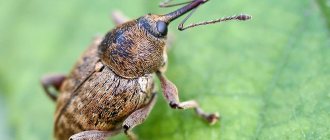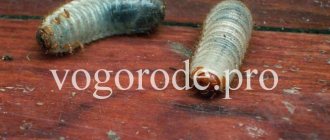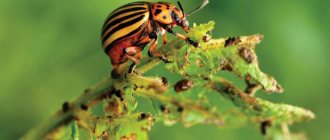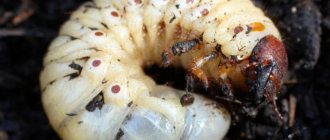The cockchafer is one of the most intrusive and dangerous garden pests. Its larvae grow and develop in the soil at a depth of about 10-15 cm, they are quite mobile and actively eat the roots and leaves of everything they meet on the way. The adult May beetle itself does not disdain the foliage systems of a wide variety of agricultural, fruit and ornamental plant crops. In a word, as soon as it is born, it begins to methodically destroy literally everything that you grow on your site. Therefore, if your plans do not include sharing your harvest with this very voracious insect, now is the time to give it a worthy rebuff.
- 2 Natural enemies of the cockchafer
- 3 Fighting the cockchafer using folk methods
- 4 Chemical and mechanical methods of pest control
4.1 Plants that the cockchafer in the photo does not tolerate
What does the May beetle or common khrushchev look like?
It is easy to identify the cockchafer. It has a large, oval body, black or brown color. The body is completely covered with a chitinous shell and is divided into three segments - head, chest and abdomen. The insect's abdomen consists of eight sections, and the chest of three.
The beetle's wings are covered with elytra of a brown or brownish color. The head is retracted into the wings and is dark in color, with some exceptions. Khrushchev also has three pairs of limbs covered with small hairs. Each pair emerges from the prothorax, mesothorax and metathorax. The tibiae of the forelimbs have 2-3 teeth.
The May beetle is a very hairy insect. There is a huge amount of hair of different lengths, colors and thicknesses located throughout its body. Usually the hair is white or gray. In some individuals, their natural color is not visible due to their hair. This feature makes cockchafers well recognizable, so they can be easily distinguished by their dense vegetation.
Stages of development
The female cockchafer lays eggs after 2-3 weeks of the life cycle. After laying, she looks for a male again and the cycle repeats. During her life, the female Khrushchev lays eggs 3-4 times, then dies. The life of a Khrushchev is divided into 4 stages:
- Egg . The cockchafer lays white eggs 0.3 centimeters long and 0.2 centimeters wide. The egg development cycle lasts from 24 to 50 days.
- Larva . As the egg develops, it hardens and then a larva forms. They are thick and curved, light in color and 65 mm in length. She can stay in this stage for up to 4 years.
- Doll . The pupa is yellowish in color and lives in the ground. It is similar in appearance to an adult beetle, but has shorter wings. It is 0.25 centimeters long. The pupal stage lasts 2-4 weeks.
- Adult beetle.
Description of the pest
The genus May beetle (Khrushchev) includes 24 species, 9 of them were found in Russia.
Insects appear as soon as the buds and leaves bloom on the trees. They crawl out of the ground, where they spend more than one winter.
These are quite large insects up to 35 mm in size. They are found in Europe and Asia, preferring forests and forest-steppes. In populated areas, Khrushchi are localized in plantings and gardens. They live and mate on trees and bushes, and lay eggs in the soil.
Based on their color, there are two types of May beetles:
May beetle nigripes.
rex, or red ones , which are characterized by a red pre-back and legs (live in places with weak shade, found in the northern regions);- nigripes, or black , with the same color on the back and legs (live in shady forests, mainly in the south).
It's easy to recognize a beetle:
- the body is covered with hair-like scales, the pile is longer on the head and foreback;
- there are antennae on the head, on which males have 7 identical plates, forming something like a club;
- has 3 pairs of limbs covered with hairs, with claws at the ends for crawling on bark and foliage;
- the wings are strong, chitinous, brown in color, attached to the second segment, transparent lethal - to the third.
4–6 weeks after the eggs are laid, white worm-like larvae hatch and remain in the soil for up to 4 years. They have a well-developed oral apparatus, which allows them to feed on plant debris and root shoots.
At the end of the last year of life in the ground, transformation into a pupa occurs. At this stage, the insect resembles an adult, but is still white in color, with underdeveloped wings. Gradually, under the influence of hormones, it finally turns into a beetle (usually this happens at the end of summer), but it emerges from the ground only next spring.
What do cockchafers and their larvae eat?
Insects fly out to hunt in the spring, when the air temperature warms up to 10-15 degrees. The main damage occurs to fruit plants; they damage leaves, flowers and ovaries. They also do not disdain spruce and the foliage of most trees: maple, linden, poplar, oak. The only plants that are safe from these pests are maple and ash.
The diet of cockchafer larvae is slightly different from that of adults. In the early stages of development, the larva consumes vegetables and some ornamental plants. When they grow up a little, they begin to eat roots; they love the roots of trees and shrubs the most. The larvae are voracious, so they can completely destroy the root of a small tree in a couple of days.
Harm of the cockchafer
The Khrushchev beetle feeds on young leaves of various trees - maples, birches, aspens, oaks, rowan trees, poplars and lindens. And in gardens, the victims of Khrushchev are such fruit trees and shrubs as cherry, sea buckthorn, plum, black currant and apple tree - the favorite tree of Khrushchev. Even lilacs attract the pest, but May beetles are not interested in herbaceous plants. It has been noticed that every 3-5 years there is a mass migration of cockchafers: red beetles develop on a four-year cycle, and black beetles on a five-year cycle. In such “summer” years, beetles can eat all the leaves on the trees within 1-2 months. But in the intervals between these “flying” years, cockchafers are almost never found in large numbers.
Not only adults, but also beetle larvae harm plants: they gnaw the roots of vegetable crops (potatoes, corn and any seedlings), fruit and ornamental trees and shrubs, strawberries, lawn grass and even some weeds. One two-year-old larva can eat the roots of a two-year-old pine tree in a week, while a three-year-old larva will need only one day to do this.
Effective ways to combat adult beetles
In the garden
If the cockchafer is infested in the garden, first of all you need to protect fruit, deciduous trees and shrubs. Most often, pests gather in calm and cool weather, in the morning and evening. You can take advantage of this by shaking them off and trampling them during periods of accumulation of beetles. This can also be done with a shovel, simply by digging up the soil once a year. This “manual” method is very effective.
Another option is to plant one of the varieties of grass in the garden that the beetleworm cannot tolerate. An example is the perennial lupine. If you remove the weeds and sow this grass, a massive death of the beetle will begin. This is a simple yet effective remedy.
An alternative to perennial lupine is white clover. This is a plant that takes nitrogen from the air and accumulates it in the soil. Khrushchev do not tolerate nitrogen at all, which makes white clover an effective fighter against the cockchafer.
One of the most commonplace methods is poison. You can take any insecticide, dilute it in water and water the soil with it. This procedure should be done about a month before harvest.
In strawberry
An effective method of controlling beetleworm on strawberries is spraying. To do this, make various solutions and spray the berry bushes with them.
Usually solutions are made with ammonia (1-3 spoons per 10 liters of water) or iodine (10-15 drops per 10 liters of water).
It is best to spray once a week 2-3 times in a row. This is how the cockchafer can be scared off the most.
Traditional methods of fighting beetles
The fight against Khrushchev using folk remedies will also be effective. An ancient way to catch cockchafers is to shake them off trees . The procedure should be carried out in the morning or evening. Individuals that have fallen from the tree are collected so that the females cannot lay eggs, and they are destroyed.
Birds can be used to get rid of the beetle . Just set them on a specific plant using cereal or any other food; you can also hang birdhouses or have chickens .
Dig a hole, place a basin in it, the edges of which will be coated with something sticky . The beetles will get stuck and won't be able to get out.
Hang a white sheet on a rope and illuminate it with a bright light . Such a trap will attract male cockchafers, they will begin to crawl at the bottom of the sheet and rustle in the grass. All that remains is to simply collect them in a separate container and destroy them. This trap does not work on females
How to fight the cockchafer using folk methods
Traps
Making bait for May beetles is easy. You need to take a large plastic bottle and cut off the neck. Then hang it on a tree, you can attach it to a thick branch, tie it with a cord and fill it with bait about 3/4 full.
Some fermentation product can serve as a bait drink. Kvass, beer or fermented jam work well.
The smell of the bait will attract insects, and once they land in the trap, they will not get out. The method is effective because, in addition to cockchafers, the trap will catch other pests.
Do you make traps for cockchafers?
Yes
No
Manually
Digging up beds is an excellent way to combat beetle larvae. By digging 30-40 centimeters between the rows, it is not possible to completely destroy the entire population of beetles, but it will definitely be possible to greatly reduce their number, increasing the chances of crop survival.
Help from insectivores
One of the most environmentally friendly and effective methods is to introduce predators into your garden that hunt for the cockchafer. Many cats and dogs, out of curiosity, catch cockchafers and bring them to their owners. In the wild, they are hunted by hedgehogs, moles and many birds.
The simplest way is to attract birds. Obviously, in order for birds to fly to the garden, favorable conditions must be created for them. Install a drinking bowl and bathing bowl, hang birdhouses on branches and poles. After some time of feeding, starlings and thrushes will begin to fly in and destroy the pests.
After destroying the cockchafer, you will have to save the crops from birds that are accustomed to feeding in your garden.
Prevention measures
In order not to have to fight cockchafers and their larvae, it is wiser to take some measures to prevent the appearance of insect pests on the site. To do this, it is necessary to mulch the soil in a timely manner. Crushed bark, eggshells, straw, wood shavings and other materials prevent adults from penetrating the soil and laying eggs there.
You can scare away cockchafers by burying cabbage leaves or mustard shoots between the rows. It is recommended to plant plants from the Cruciferous family, turnips, turnips or elderberries along the perimeter of the beds.
Khrushchev larvae like to climb into compost heaps for the winter. Therefore, to prevent their appearance next year, it is necessary to lay a piece of film under it. It will prevent insects from getting into the ground. And with the onset of frost, the compost needs to be scattered. Then all the larvae will die from the cold.
Chemicals for control
Antikhrushch
Antikhrushch is a pesticide against Khrushchev larvae. The main advantages of this drug:
- environmentally friendly;
- long-lasting;
- rain resistant.
Available in the form of a suspension. To use, you need to dilute the concentrate in water, depending on the crop being treated, and spray the plant before planting. Suitable for potatoes, cabbage, tomatoes and fruit tree seedlings.
Aktofit
Pesticide against many insect pests. Can be used for both indoor plants and agricultural crops. Cannot be used in the rain. Unlike antichrusch, it kills adults, and not just larvae.
Works due to neurotoxins. When the active substance enters the body of the cockchafer, it has a detrimental effect on its nervous system, as a result of which it dies after some time.
To use, the product must be mixed in water and sprayed evenly over the leaves of the plant.
Actofit can only be used at temperatures above 18 degrees.
Bazudin
Bazudin is an insecticide that kills pests by contact. The advantage of the drug will be long-term protection with low consumption. 30 grams of basadine is enough to cultivate 20 square meters of land.
This drug is toxic to fish, so you should strictly avoid getting it into water bodies. It causes minimal harm to humans.
Available in granule form. To prepare bazodin, you need to take a jar, fill it 3/4 full with sand, add the drug, then mix. To protect potatoes, you need to add the mixture to the hole before planting; the soil surface of cabbage is treated. Flower crops are processed in the same way as potatoes.
Zemlin
Another insecticide. Protects crops from many insects, in addition to beetles. To protect flower plants, it is sprayed on the surface of flowers in a dosage of 30 grams per 20 square meters. To protect the potatoes, add 10-15 grams per hole when planting. Active ingredient: diazinon (50 grams per kg).
Initiative
In addition to Khrushchev, it destroys other soil pests. All effects are the same with earthling. It has a long protection period due to packaging in the form of granules.
It does not need to be diluted with anything; it is added to the ground during planting and acts throughout the life cycle of this plant. Valid for 24 hours after use.
Biological drugs
Boverin
Another insecticide "Boverin". It is a preparation based on the sporozoan mushroom Beauveria bassianl, which is poisonous to insects.
When it gets on the body of an insect, it begins to germinate and penetrate inside the beetle. Once the pest enters the body, it releases toxic substances that quickly kill it.
Nemabact
Biological product against pests in the soil. An undoubted advantage is that it is environmentally friendly and does not harm humans and their pets at all. Kills the beetle at the larval stage.
Used for watering in the morning and evening. After taking it, the larva dies within 1-3 days. There are restrictions on temperature, can only be used at 10-26 degrees and high humidity.
Folk remedies
No matter how effective chemical or biological agents against Khrushchev are, folk methods of dealing with unwanted guests in the garden will never lose their relevance:
- An effective folk remedy is to collect cockchafers from bushes and trees. Beetles are usually collected in the morning and evening in calm weather. The advantage of the method is that the insects can be fed to birds or used as fishing bait. Otherwise, they should be burned or trampled.
- If you have chickens or other poultry, you can use this as a weapon against pests. Having released them into an area where there is no risk of damage to the crop, they will quickly pull out and eat many beetle larvae.
- Dissolve 6 grams of potassium permanganate in 10 liters of water. Water the suspected habitats of the cockchafer with the solution. After a while this will scare them away.
- Table salt is also a good method of prevention and control. Pour a glass of regular salt onto a bucket of water. Watering beetles with this solution also gives results.
Living at home
Experimenters are trying to provide conditions for the beetle to live. The most common method is a box with plucked grass, but from the above it is clear that these conditions are not suitable for the beetle to live. And whether they eat simple grass is unclear. Experienced naturalists recommend placing the insect in a pot with garden soil.
An adult insect will live for a maximum of a week; they live in freedom for 1.5 months during the active mating season, which begins on May evenings, in dry weather.
During this period, females lay 60-90 eggs and, having laid the last clutch, die. Males die earlier, having completed the function of fertilization. But the larva, gradually growing, lives much longer. Pests feed well, but are they eaten by other living creatures?
Planting lupine for prevention
Lupine is a perennial plant of the legume family. A beautiful and bright plant that decorates any garden or room. But don't underestimate its practical qualities. Firstly, lupine has a very positive effect on the soil in which it grows. It strengthens the soil and protects the ground from weeds that chafers feed on. Secondly, it collects nitrogen from the surrounding air and enriches the soil with it, destroying the larvae.
Lupine is an unpretentious and resilient plant that does not require constant care. This flower is an assistant in protecting against pests, and also decorates the area.
The cockchafer is a nasty insect. It infuriates many farmers and is really difficult to combat. However, modern technology provides opportunities for pest control, from chemicals to old folk methods.
Which method to choose depends on the conditions in which the garden is located. You can use expensive chemicals or traditional methods - the result will not be much different.
Folk recipes against Khrushchev larvae
How to kill the cockchafer larva? The most popular, but labor-intensive way to get rid of cockchafer larvae is their mechanical collection . In the spring, when the ground begins to warm up sufficiently, the larvae rise higher into the warmth and moisture. You can find them at a depth of 10-20 cm . It will not be possible to collect all the larvae, and digging up the earth is not such a useful process for farming.
To combat cockchafer larvae using folk remedies, sow the affected area with lupins . Weeds do not grow next to the lupine, which means the larvae will have nothing to eat, so they will die.
To save potatoes from larvae, a weak solution of potassium permanganate . You just need to spray it under the leaves of the plant.
Seed the area under the plant with white clover . The nitrogen, which will be synthesized by the bacteria located in the clover roots, will make the soil unsuitable for larvae to live in, but fertile for plant growth.
You can save currants and strawberries by spraying with a solution of onion peels . 100 grams of husks are infused in 10 liters of water for 5 days. The tincture is diluted in a 1:1 ratio and sprayed onto the affected plants and the ground underneath them.
